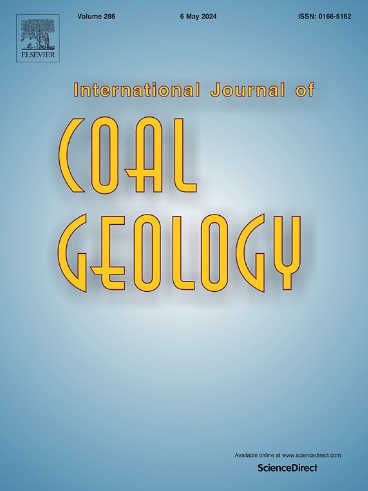Organic matter accumulation, paleoenvironment and kerogen structure of the Middle Jurassic Dameigou Formation, Qaidam Basin: Evidence from organic petrography and geochemistry
IF 5.7
2区 工程技术
Q2 ENERGY & FUELS
引用次数: 0
Abstract
The organic matter in terrestrial sediments provides not only a record of geological events but is also as a vital source of fossil fuels. Its enrichment is fundamentally governed by the interplay of complex depositional environments and diverse climatic conditions. This study presents an integrated investigation utilizing major element oxides, trace elements, rare-earth elements, organic petrography, pyrolytic analysis, and infrared spectroscopy to systematically evaluate the provenance, tectonic setting, paleoclimate, weathering conditions, and organic matter accumulation of the Middle Jurassic Dameigou Formation, as well as to elucidate the chemical composition of kerogen. Geochemical parameters, particularly the Th/Sc vs. Zr/Sc ratios, indicate the absence of recycled sediments throughout the studied succession. Geochemical discrimination diagrams, particularly the Th/Sc vs. Zr/Sc and La/Th vs. Hf plots, provide compelling evidence for felsic volcanic rocks serving as the predominant source material.The interpretation of the tectonic setting as an active continental margin is constrained by multiple discrimination diagrams, such as the La–Th–Sc and Th–Co–Zr/10 ternary systems. The depositional sequence exhibits distinct vertical variations in organic matter composition and paleoenvironmental conditions. Unit 1 is characterized by terrestrially derived macerals (vitrinite and inertinite), while units 2 and 3 show a progressive transition to liptinite-dominated assemblages, primarily composed of lamalginite. Multiple chemical weathering proxies, specifically the Chemical Index of Alteration, Weathering Index, and Sr/Cu ratios, demonstrate that paleoclimatic conditions evolved from warm/humid environments characterized by intense chemical weathering towards cooler conditions with diminished continental weathering intensity. Molecular-level characterization using μ-FTIR and CP-Py-GC/MS reveals distinctive organic matter compositions: unit 1 is dominated by aromatic structures (73.0–83.5 %), while unit 2 shows predominant aliphatic compounds (41.6–72.9 %). The decrease in aliphatic compounds to 39.2 % in unit 3 correlates with increased water salinity, suggesting environmental control on kerogen composition. The δ13C values exhibit stratigraphic variations, with comparatively higher values in Unit 1 (−33.01 ‰ to −25.70 ‰) compared to lower values in Units 2 and 3 (−41.56 ‰ to −28.79 ‰), reflecting the higher abundance of terrestrial maceral components in Unit 1 and proximal Unit 2 deposits. These findings provide crucial insights into the depositional evolution and organic matter accumulation mechanisms in the study area.
柴达木盆地中侏罗统大梅沟组有机质聚集、古环境与干酪根结构:来自有机岩石学和地球化学的证据
陆地沉积物中的有机物不仅提供了地质事件的记录,而且是化石燃料的重要来源。复杂的沉积环境与多样的气候条件相互作用是其富集的根本原因。利用主元素氧化物、微量元素、稀土元素、有机岩相学、热解分析、红外光谱等综合研究手段,系统评价了中侏罗统大梅沟组物源、构造背景、古气候、风化条件、有机质富集特征,阐明了干酪根化学组成。地球化学参数,特别是Th/Sc和Zr/Sc比值,表明在研究的演替过程中没有再循环沉积物。地球化学判别图,特别是Th/Sc / Zr/Sc和La/Th / Hf图,提供了令人信服的证据,证明长硅质火山岩是主要的物质来源。构造背景为活动大陆边缘的解释受到La-Th-Sc和Th-Co-Zr /10三元体系等多重判别图的制约。沉积层序在有机质组成和古环境条件上表现出明显的垂向变化。第1单元以陆源显微组分(镜质组和惰质组)为特征,而第2和第3单元则逐渐过渡到以泥质组为主的组合,主要由斑藻质组组成。化学风化指数、风化指数和Sr/Cu比值表明,古气候条件由化学风化强烈的温暖/湿润环境向大陆风化强度减弱的凉爽环境演变。利用μ-FTIR和CP-Py-GC/MS对其进行分子水平表征,发现其有机成分明显不同:单元1以芳香族结构为主(73.0 ~ 83.5%),单元2以脂肪族化合物为主(41.6 ~ 72.9%)。第3单元脂肪族化合物含量下降至39.2%与水盐度升高有关,表明环境对干酪根组成有控制作用。δ13C值表现出地层差异,1单元δ13C值较高(- 33.01‰~ - 25.70‰),2、3单元δ13C值较低(- 41.56‰~ - 28.79‰),反映了1单元和2单元近端陆相显微组分丰度较高。这些发现为研究区沉积演化和有机质聚集机制提供了重要的认识。
本文章由计算机程序翻译,如有差异,请以英文原文为准。
求助全文
约1分钟内获得全文
求助全文
来源期刊

International Journal of Coal Geology
工程技术-地球科学综合
CiteScore
11.00
自引率
14.30%
发文量
145
审稿时长
38 days
期刊介绍:
The International Journal of Coal Geology deals with fundamental and applied aspects of the geology and petrology of coal, oil/gas source rocks and shale gas resources. The journal aims to advance the exploration, exploitation and utilization of these resources, and to stimulate environmental awareness as well as advancement of engineering for effective resource management.
 求助内容:
求助内容: 应助结果提醒方式:
应助结果提醒方式:


